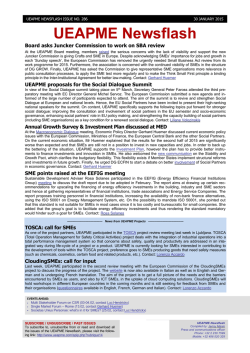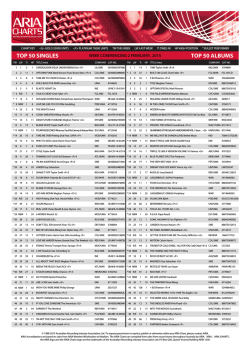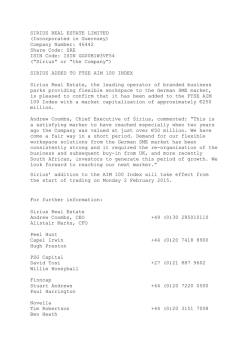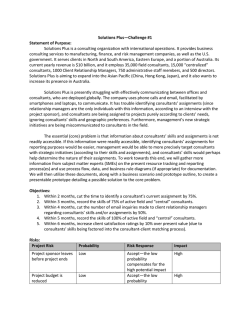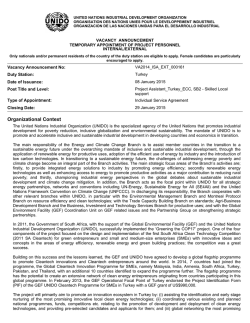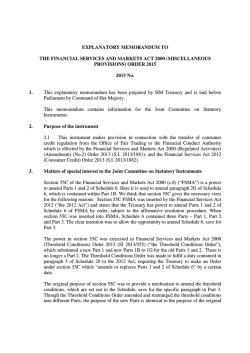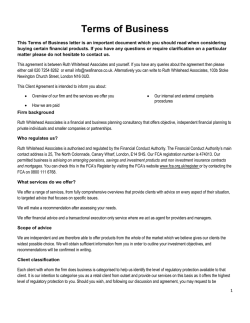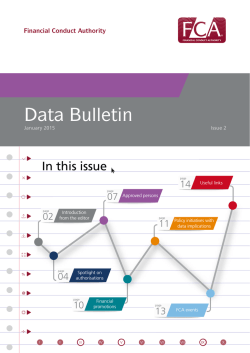
Small- and Medium-sized Manufacturing Enterprises in Cambodia:
Japanese Journal of Administrative Science Volume 15, No. 2, 2001, 145-156. mwiimn^msmm 2 -t, 2001, 145-156. m Small- and Medium-sized Manufacturing Enterprises in Cambodia: Effects of Key Managerial Functions on Business Success Chet CHEALY (Nagoya University) This paper primarily focuses on how business outcomes of Small- and Medium-sized Enterprises (SMEs) in Cambodia is affected by the way by which the four key managerial functions are practiced, i.e. HRM, finance, marketing, and production-technology functions. Results from t-test based on the sample of 112 manufacturing SMEs in the Phnom Penh area, Cambodia showed that there were significant differences between successful and non-successful firms in terms of practices of the four functions and business performance. Regression analyses revealed that two key functions (HRM and marketing) had significant and positive contributions to profit growth. 1 - What are the characteristics of Cambodian Introduction SMEs? Cambodian economy was improperly managed 2 —What are the determinants of business suc cess in manufacturing SMEs in Cambodia? and isolated due to the exceeded state control that followed after the civil war for decades since 1970s (UNDP, 1987). Consequently, Cambodia now is one of the poorest countries in the ASEAN region with GDP per capita of only US$256 in 1999. Conceptual Analysis and the framework for the study To It is noticeable that the SME concept and theories alleviate the poverty, Royal Government of Cambo are built and developed based on experiences of dia (RGC) has set up a multi-pronged strategy in industrialized economies where the context is differ which SME development comes into one of its fore ent from that of developing economies. It is doubtful front policies (Royal Government of Cambodia, 1996, to what extent these concepts and theories are appli 2001). cable to the developing economies (Cook, 1*996). Yet, the SME and manufacturing sectors in Cambo Arguments on differences in the nature of SMEs in dia as a whole are poorly developed and documented, the two worlds are observable in and less has been known about the field. argument of reasons behind the emergence (or Lean two areas: an literature exists in both forms, availability and the re-emergence) of SMEs and discussions on manage quality, therefore, effective and efficient policies has ment of SMEs. never been made without sound data and under Debates on the SME concept Discussions of reasons behind the emergence of standing of the field. Based on the above-mentioned view, it is of great value to investigate how key managerial functions critical for development of SMEs (Boliko SMEs point out the segmentation of market, the advancement of information technology, and protec and tion policies by the government. Scitovsky (1978) Wakabayashi, 1994) would affect their business asserts that SMEs emerged as a consequence of outcomes in Cambodia. Hopefully, empirical findings trends towards differentiation of the market into in derived from the present study can contribute to the an increasing numbers of segments. The segmenta improvement of policies supporting the SME sector tion leads to multiplication of fashions for various development in Cambodia. Research questions of the types of consumers. Higher individual incomes allow present study state as follows. a growing number of consumers to satisfy their -145- ss?ri»4s*»i5**2^ needs for variety and thus for differentiation. This where living standards of the people are very low phenomenon is well-known to marketing specialists. and most of their income is non-monetary. Taking The demand that lasts for short run seems to be the case of Cambodia, about 87% of her arable land is accentuated by new distribution behavior that is under rice yielding with providing income little more forcing distributors to minimize the time between than the subsistence level (ILO, 2000). With income orders and sales. Thus SMEs are more likely to adapt so low across the country, the pattern of demand is to the growing "specialization" of market and faster biased towards goods that are affordable by the poor changes. Along with this, Julien (1998) adds that the in Cambodia. emergence of SMEs is a result of the development of Against the concept of protectionism, there are new computer technologies that are much better practical concerns over how to implement such a suited than before to the competitive requirement for policy in developing countries. Previous attempts at small firms, namely in access to information and protection in some countries in the nome of import market. substitution have actually made businesses more In addition some researchers continue to argue that emergence of SMEs is a result of protection isolated and less competitive. The capacity of many countries' public administration systems for effec policies taken by governments of some economies. tively implementing trade protection policies is For example, ILO (1998) pointed out the continued questionable. In general, the key problem of advocat absence of vigorous responses from the business ing more active government interference rests in its sector to 'supply-side' improvements in some econo capacity to deliver well-balanced industrial policies mies and questioned the ability of neo-classical in developing economies. Therefore, reforms which approaches to bring about major economic growth. help remove or reduce the direct role of government They, therefore, propose a more pro-active role for are more likely to be successful than adopting biased government to assist SMEs. One specific revision to protection policies. Indeed, the interventionist suc the standard framework that has been proposed cesses in East Asian economies can be partly attrib concerns the infant industry protection to make uted to the efficacy of their civil service systems favorable environment for emergence and develop (ILO, 1998). A synthesis on SME emergence in developing ment of SMEs. It is certainly the case to see econo mies that have achieved the highest growth in the countries can be made based on results from the last 30-40 years in Asia have done so with the help of structural adjustment policy where a some degree of protectionism for key industries. environment was created for the private sector. In Furthermore, in East Asia, the protection offered by developing countries, SME and informal sectors are favorable tariff or non-tariff shields provides the active but indiscernible. A labor market change favorable opportunity for major investment, technological followed after the structural adjustment policy has advancement and economic growth0. been the factor of emergence of these sectors. Contrasting to these concepts, empirical evidence Pedersen (1998) asserts that the emergence of both gives different reasons for SMEs emergence in devel SME and informal sectors is in response to the in oping countries. Computer advancement may not crease in the unemployment rate. The case becomes explain the emergence of SMEs due to the fact that more obvious in urban and non-agricultural areas developing countries lag behind this advancement. where high unemployment and active entrepreneu And in contrast to Scitovsky's concept of demand for rial attempts are prevailing simultaneously. Given products with unique quality and fashion, such this concept, SME and informal sectors are likely to demand cannot be available in developing countries increase in a period of crisis when the formal sector only slowly grows to absorb labor surplus. A large 1) See argument, for example, in Report of com part of literature has taken the position to interpret mittee of donor agencies funded interventions, the growth of SME and informal sectors after struc Geneva, Switzerland, 1998. tural adjustment where deregulatory policies applied -146- Small-and Medium-sized Manufacturing Enterprises in Cambodia: Effects of Key Managerial Functions on Business Success by governments of transitional economies to de financial market not because of barriers (i.e. the regulate and remove barriers preventing entries of gaps) but because they wanted to maintain their new firms and to create a business-friendly environ control on daily management of the firms. And thus ment to lure participation of the private sector. Duval they simply resorted to financial sources with less and Waterfield (1996) set four pillars to describe restriction on loans even with higher interest rates. market-friendly environment that is supportive to He concluded that SME entrepreneurs prefer internal SME. They are: 1) a stable macro economy, 2) a financing to external financing. If external financing competitive micro economy, 3) global linkage, and 4) is necessary they prefer the short term less restrictive investing in people. one. In addition to the debates on SME's emergence, academicians as well as practitioners argue on suc cessful management of SMEs. Because, plenty of existing literature on management of SMEs focuses On the other hand, some scholars indicate that management of innovation based on people is the basis of small business success. Ogawa (1994) pointed out that SME management should be slanted on causes of SME failures, financing seems to be the toward care for people. major area of emphasis to explain reasons behind the and a solid sense of belonging among employees failure. provide the foundation for small business prosperity. Pissarider (1999) asserts that the survey around small business owners indicated that a lack of Reliable communications Boliko and Wakabayashi (1994) developed assump financing is an obstacle to doing business and com tions on the critical importance of HRM to sustain pany growth. A theory of SME financing has been business success. built around accessibility to financial market2). It is that although capital and technology are essential to a common sense that the limited access is caused by entrepreneurial success, people the most important One of their assumptions states what is called the financial gap. The financial gap asset for the firm, play a critically important role in seems to have two main components: 1) knowledge the achievement of business prosperity. In short, the gap, and 2) supply gap. The knowledge gap is the success of SME management is not solely based on lack of knowledge about different sources of financ financial, market and technology aspects, but more ing and their advantages and disadvantages. importantly on the quality of human resource, a key The supply gap means that funds are not available for player of SME business success. SMEs, or that even some financing sources are Given the above argument, the present study available to SMEs but at a much higher cost than to adopts an assumption that both financial and non- large firms. financial functions for business management deter In contradiction to the above concept, literature mine the SME business success. In other words, as shows that most of SME entrepreneurs, especially shown in Figure 1, the processes of managing the those in developing countries, cannot clearly distin following key four functions, namely HRM, finance, guish their business assets from personal ones. In the marketing, and production-technology functions, are discussion of financial structure, some researchers assumed to affect business outcomes in significant refer to the key roles of the owner's personal equity, ways. It is also assumed that the emergence of SMEs and the extensive overlap between the personal is prompted as a consequence of government policy wealth of the business owner and the resource for the changes, for example structural adjustment policies business. This unclear boundary fills the financial that bring about a removal for entry barriers of new gaps for the growth of business and makes SME firms and help reduce production and management entrepreneurs to avoid outsider's involvement in costs of firms due to de-regulation. Bearing this management of their businesses. Calof (1985) con framework, the following two hypotheses are set to firmed that SME entrepreneurs did not enter into be tested in this study. They are: 2) See for detail in Small Business: Critical Per ing the four key managerial functions (HRM, fi -HI: Successful SMEs are more active in perform spectives on the Business Management, 2000 nance, marketing, and technology function) than 147- IS «Sff»*4^*15#*2-^ 9 Background Variables • -> Process Management Firm's HRM and Finance -^Business Outcomes Growth in >* and Marketing Entrepreneur's Profil Technology Backgrounds Figure 1 Size p A Framework for Analyzing SME Business Success non-successful SMEs. Measurement —H 2: Among the four managerial functions, the i) Managerial Functions: Four managerial functions HRM function contributes most significantly and (HRM, finance, marketing, and technology) were positively to the success of a firm measured in terms considered in this study, a) HRM items included: (1) of growth in size and profit. practices of human resource development in terms of learning-by-doing practices, on-the-job training, and Method training given by the supplier, and (2) the quality of For the purpose of testing the above hypotheses, a firm's human resource in terms of creativity, coop questionnaire survey was carried out in March 2001 eration, and work motivation among employees, b) with 112 entrepreneurs sampled from manufacturing Finance functions consisted of a self-evaluation on SMEs in the Phnom Penh area, Cambodia. Prior to financial adequacy of the firm by using two question the questionnaire survey, visits to several govern items: financial standing and access to the additional mental and non-governmental organizations were fund, c) Marketing items included: (1) marketing made in order to obtain related information for the strategy in terms of price adjustment, quality adjust research and survey. ment, improvement of distribution, market segmen The organizations included Department of SME (Ministry of Industry, Mine and tation, and advertisement, and (2) a marketing Energy), Department of Technical and Vocational system in terms of retailing, wholesaling, subcon Training, Department of Higher Education (Ministry tracting, and government contract, d) Technology of Education, Youth and Sports), ILO Cambodia, items included: (1) technology input in terms of UNDP (United Nations Development Programme) condition of machinery, usage of public electricity, Cambodia, and ACLEDA (Association of Cambodia supply of machines and spare parts, and (2) technol Local Economic Development Agencies). ogy policy in terms of policy development, R&D, and Due to the majority of SME entrepreneurs in technology information. All variables were meas Phnom Penh are Chinese decedents, the difficulty in ured by a 5-point scale ranging from 1 lowest (or reading and writing Khmer, the official language of never) to 5 highest (or always). Cambodia, was observable. To avoid possibility in 2) Business Outcome: Two performance items were making mistakes, it was decided that interviewers used to evaluate the outcome of business activities: read questions and wrote answers for the sampled size growth and profit growth in the past period. Size SME entrepreneurs. growth was scored based on the size-change ratio, This time-consuming method required both interviewers and respondents to com that is: current size minus beginning size divided by municate face-to-face, and to double check questions years of operation. Negative ratios were considered and answers in order to ensure the accuracy of to be "non-success" in terms of size growth, while zero collected information. and positive ratios were considered to be "success" in terms of size growth. The profit-change is a self- 148- Small-and Medium-sized Manufacturing Enterprises in Cambodia: Effects of Key Managerial Functions on Business Success evaluation given by the firm. The scale ranges from current size of the firm, (2) the current level of profit "1"= declining profit comparing to the beginning the firm gains, (3) the level of HRM practices (HRM), year, through "2" = stable profit comparing to the (4) the level of financial adequacy (FIN), (5) the beginning year, to "3"= increasing profit comparing level of marketing practices (MARKET), and (6) the to the beginning year. This implies that values "2" level of technological capability (TECH) of the firm. and "3" are for stable or increasing profit comparing In terms of management functions, the above result to the beginning year. Like size-change, firms with means that there are significant differences between value "1" are considered to be non-successful, while the two groups of SMEs in regard to performing four those with "2" and "3" are considered to be successful. managerial 3) Control Variables: Eight variables corresponding marketing, and technology functions. The firms that to firm's and entrepreneur's characteristics were used have higher emphasis on the four functions are likely as control for explaining the SME success. They are: to belong to successful group. Therefore, Hypothesis (1) Current size of the firm (1= micro and small, human resource, finance, 1 that states successful SMEs are actively performing key managerial functions (HRM, finance, marketing, 2 = medium sized) (2) Industry (1= garment-related, 2 = food/beverage -related, functions: 3 = construction material-related, and technology) significantly more than non- successful SMEs is accepted. 4=other) (3) Age of the firm (l=not more that 5 years, It was found that successfully growing SMEs in 2 = older than 5 years) terms of size are more active than non- successful SMEs: 1) in conducting HRD practices and enhanc (4) Variety of products (l=not more than 2 types, ing the quality of human resources, 2) in managing 2 = 3 types and more) financial functions regarding the adequacy of work (5) Education of entrepreneur (1 = less than or equal ing capital for expanding business, 3) in managing to primary level, 2 = higher than primary) marketing issues with respect to strategies (price (6) Age of entrepreneur (l=less than 45, 2 = older and quality adjustment, distributing system, segmen than 45) tation of market, and advertisement) (7) Years of entrepreneur experiences (l=less than and sales networking (contracts with large firms and govern 5 years, 2 = longer than 5 years) ment, wholesaling, and retailing), and 4) in manag (8) Types of entrepreneur experiences (1 = traderelated, 2 = others) ing technological functions involving technological Statistical Procedure inputs (machinery, power, spare parts) and policy development (R&D, seeking information, clear pol Initially, a series of t-tests were applied to find characteristics of successful firms (successful vs. icy). The same results were observed with respect to non-successful entrepreneurs). Secondly, multiple profit growth as shown in Table 1. These results regression analysis was applied to find determinants indicated that for the SME business success, proper of business outcomes by introducing four functions management of business process in terms of four key of management with background variables as con functions is critical. Also, two success criteria used trols. for the present study, ratios of size growth and profit growth, Result and Discussion were found to be considerably inter- correlated, and tend to be determined by the same set of factors simultaneously as t-test results in Table 1 1) Differential Characteristics of Successful and Non-successful SMEs: indicate. To differentiate the characteristics of successful 2) Determinants of Managerial Functions for and non-successful SMEs, t-tests were conducted. Business Success: Results in Table 1 indicate that the two groups of In order to identify factors contributing to explain firms are significantly different from each other in 6 ing managerial functions and determinant factors surveyed. They are (1) the multiple regression analyses were conducted. 149 business success, As mi7mn¥%i5m%2^ Table 1 Result of t-tests conducted over 10 items between success and non -success SMEs ^^-^^^ Variables ^"~~"^^^^ Size Growth ^^^-^_ Success Non success Average n = 82 n = 30 112 37.46 21.17 33.10 4.77 *** 24.6 1.40 1.92 4.58 *** Current size of firm Annual profit of firm Age of firm t P 4.16 4.63 4.69 .05 45.60 44.90 45.41 .68 6.74 6.70 6.73 .05 Level of owner's education 1.18 1.20 1.19 -.19 Score for HRM 1.81 1.50 1.72 4.59 *** Score for FIN 2.52 1.97 2.37 3.15 ** Score for MARKET 2.53 2.26 2.46 3.3 Score for TECH 2.22 1.86 2.12 5.03 Age of owner Years of owner's experience ** *** Profit Growth Success Non-success Average 35.70 28.03 33.10 5.34 2.39 1.00 1.92 15.82 Current size of firm Annual profit of firm Age of firm t p * *** 4.58 4.76 4.69 .43 45.57 45.11 45.41 1.7 Years of owner's experience 7.04 6.13 6.73 3.50 Level of owner's education 1.20 1.16 1.19 .29 Score for HRM 1.18 1.50 1.72 9.63 *** Score for FIN 2.58 1.97 2.37 10.07 *** Score for MARKET 2.63 2.13 2.46 5.54 *** Score for TECH 2.22 1.94 2.12 7.90 *** Age of owner p<.05, ~p<.01, ~p<.001 shown in Table 2, among background variables on variables. Also, years of business experiences showed firms and owners, industry shows strong impacts positive influences except for size growth and mar both on managerial functions and success criteria. keting functions. These results suggest that SME Since coding of industry is made for the garment entrepreneurs with long years business experiences industry to take the value "1", food and beverage "2", in trade-related business are likely to succeed, espe construction "3", and other "4", the negative coeffi cially in achieving profit growth in the Cambodia cient for industry means a strong garment industry SME development context. effect. Thus, this result shows that being in the Regarding the effects of managerial functions, two garment industry is a benefit for actively performing functions, HRM and marketing, showed HRM practices, marketing function, and technologi impacts on the growth of profit, but no managerial cal activities, and above all for achieving both size functions had significant positive effect on the size and profit growth for the firm. Likewise, a product growth after firm characteristic variables entered strong variety variable showed rather consistently signifi into the regression. However, this finding still gives cant effect, although it failed to contribute to explain support to Hypothesis 2 because the t-test result in ing the HRM, marketing functions and size growth. Table 1 clearly indicated the importance of the four It is interesting to see that owner's background, functions for both size and profit growth. In sum especially their past experiences as being in trade- mary, Table 2 indicates that among the four manage related businesses, have significant rial functions, HRM (£ =.23, p<.01) and marketing effects on both managerial functions and growth (£ =.19, p<.01) affect SME success in terms of profit consistently -150- Small-and Medium-sized Manufacturing Enterprises in Cambodia: Effects of Key Managerial Functions on Business Success growth significantly and positively. This means Cambodia. Since this study took place only in the firm's efforts for management Phnom Penh (capital) area, it is hard to find firms human resource practices and diversifying marketing strategies and with financial problems that may exist outside this sales network systems will lead to the firm's financial area. In other words, the financial issue is not viewed profitability. Based on this finding, Hypothesis 2 by SME entrepreneurs in the capital area as con stating that among the four managerial functions, straints to firm's growth as serious as other issues HRM significantly and positively contribute to the such as training of human resources and expanding success of SMEs in terms of size and profit growth is market. ACLEDA (1998) evidently found that micro accepted. and small enterprises in Phnom Penh are more It is evident that finance and technology functions vibrant than those in provincial towns and rural themselves are strongly determined by entrepre areas in terms of financial adequacy, and for that neurs' years and types of experiences. reason the former may be considered to be in less Therefore, need of financial assistance. after controlling the effects of these entrepreneur Thus, financial assis characteristics, effects of finance and technology tance given to SMEs in the Phnom Penh area may functions on success measures have disappeared. contribute to encouraging rural-urban migration This finding indicates that these two functions are more than to the development of SME sector nation subject to the above entrepreneur characteristics, wide. It is also noticeable that ILO (2000) indicated rather than to be independent determinants of SME that the purchasing power in Cambodia is very low success. due to the low living standards. People place their demands for goods with cheaper prices that they can It is premature to give a conclusion based on the present study that finance and technology functions afford to buy. Parallel with this low purchasing are not the determinants of business success in power, there are other two more factors that make Table 2 Results of multiple regression analyses on managerial functions and business outcomes Managerial Functions HRM B T Business Outcome MARKET FIN 0 t B t SIZE Growth TECH B t B t PROFIT Growth B t SIZE Growth B T PROFIT Growth B t Firms' Characteristics Size of firm Industry .18 -.34 2.29" .17 -4.01 -.04 -.54 -.16 -1.97 2.33" -.22 -2.65- -.31 -.10 -1.34 .09 1.24 -3.8- .18 2.14* .11 -.39 -4.43 ~ -.39 1.6 -5.60- .12 1.46 -.27 -2.76" -.26 .05 -3.64- .84 Age of firm .00 -.08 -1.12 - .04 - .59 .07 .84 - .04 - .64 .07 .96 -.01 -.24 Variety of product .18 2.23 .17 2.29' .13 1.66 .19 2.50* .13 1.59 .21 3.12" .06 .70 .12 1.92 Edu. of owner .01 .19 .01 .16 .08 1.05 .04 .52 - .05 - .58 .02 .30 - .06 - .74 .00 .00 Age of owner .02 .29 .04 .57 .17 2.04* - .08 - .99 - .00 - .09 - .06 - .91 - .00 - .03 -.11 -1.70 .18 2.9** -.14 -1.53 .11 -.42 -6.18- -.14 -1.43 -.22 Owner's year of exp. .11 Owner's type of exp. - .30 .08* 1.5 ~ .32 4.37 ~ .06 .89 .33 4.52 - - .05 - .67 - 3.62 -.32 -3.99- -.48 -5.99- -.26 -3.32" -.26 -3.04" R-square (1) .42 .47 .45 .46 .37 Adj. R-square .38 .43 .41 .42 ,32 11.48~ 10.64 - 11.35- F. 9.67~ 7.60- 1.68 - 2.99 ** .60 (Not applicable) .57 20.00- Managerial Functions HRM .19 1.70 .23 FIN .00 .05 .13 1.67 MARKET .02 .19 .19 2.31 "* • 1.55 - .02 TECH (Not included in the regression) (Not included ir the regression) R-square (2) .17 .42 Adj. R-square .35 F. 6.05- Note: 'p<05, **p<01, ~p<001 151 2.83" - .26 .69 .65 18.91 - «s-s»f4^*i5s*2*t the technology temporally less important for the found to be the strongest determinant (ft = -.22). As First, low mentioned earlier the negative coefficient is due to skilled labor that is more suitable to be employed by coding for the experience type. This finding suggests business success for Cambodian SMEs. SMEs is plentiful in Cambodia. Second, technology that the trade-related experience is important for an information and procurement of equipment are entrepreneur to run a successful SME in the present limited in Cambodia. This may cause the cost of business context in Cambodia. Probably, because the machinery and production itself to be high, so that nature of trade persons are more alert to the business SME owners would have to choose low technology surroundings and make efforts for profit making solusions. Firms that can take advantage of these than other types of entrepreneurs. conditions, namely adapting a labor-intensive strat The second determinant from the background egy instead of technology intensive one, are more factors is the industry where business is in ( ft = likely to be successful in the current Cambodian —.26). Again, the negative coefficient is due to the socio-economic context. coding method. Garment-related industry appears to Overall, in Table 2 an introduction of the four be a growing industry in Cambodia and thus SME managerial functions into a regression following entrepreneurs in this industry enjoy the boom as after firm characteristics variables contributed to well. Since large enterprises in the garment-related increase R square value from R2 =.37 to R2 = .42 for industry in Cambodia have access to the larger and size growth, and from R2 =.60 to R2 =.69 for profit more profitable markets in the US, EU, and Japan. growth. These incremental increase, namely (AR2 Thanks to the Most Favored Nation (MFN) and = .05 and A R2 = .09, for size and profit growth re Generalized System of Preference (GSP) treatments, spectively were found statistically significant at the this industry becomes the country's fast-growing p<.01 value. These results indicate that the contri sector (Hach, Huot, Boreak: 2001). The chance of butions of managerial functions put together are having profitability trickles down from export- significant beyond the effects of all background oriented large firms to smaller SMEs though subcon variables. This finding gives a strong support to tracting and other linkages. hypothesis 1. Among the four managerial functions, only two functions (HRM and marketing) positively and Conclusion significantly contributed to profit growth of the In conclusion, based on the present study a set of determinants for development of SMEs in Cambodia firms (ft =.23, ft =.19 respectively). It is premature, however, to simply conclude that finance and tech was found. There existed significantly differences nology do not determine SME success in Cambodia. between successful and non-successful SMEs in the Looking at a correlation matrix in Appendix 2 and way the respective group of firms perform key results of t-tests in Table 1, there are significant managerial functions in relationship existing between these functions (fi doing their businesses. Firms that highly value and practice the four key nance and technology) and size and profit success. managerial functions are more likely to be in success As mentioned earlier, labor employed by the SME ful group that have increased profit and size. sector in developing economies is low skilled. Figure 2 illustrates a path diagram of effect deriv ing from determinants of SME business success In Cambodia this kind of labor is plentiful. In contrast, information on technology and* the procurement of (profit growth) in Cambodia based on findings of machinery are priced very high. this study. According to this diagram, profit growth have to make choices between the labor-intensive Therefore, firms of the firm is determined by a number of factors from way of production with cheap labor and backward both the background of the firm and the entrepre technology, or expensive advanced technology. neur, and the way managerial functions are per addition, the adequacy of working capital does not formed by the firm. Among the background charac necessarily guarantee success of the firm without a teristics, the type of entrepreneur's experiences is wise and skillful management of the other key 152- In Small-and Medium-sized Manufacturing Enterprises in Cambodia: Effects of Key Managerial Functions on Business Success .23 .19 Profit Growth .26 .22 Figure 2 Path of Determinants on Profit Growth managerial functions. This means that the finance findings by Boliko and Wakabayashi (1994) and function can be determined by other functions, thus Wakabayashi and Boliko (1994). Policies for assist making it not outstanding determinant of ing SMEs especially in the Phnom Penh area should SME include non-financial supports as much as possible. success. To sum up, the findings of this study lead to needs for designing the new methods of assisting SMEs in Cambodia. Not only financial support but also non-financial supports, such as training-, and market These kinds of services have to be available to enhance the manaagerial capacities of entrepreneurs and strengthen the operations of key managerial function for SMEs. ing-related education and services, are useful for the growth of SMEs. Based on this study, the two mana gerial functions, human resource and marketing, were found to play significant roles in bringing prosperity to SMEs. This result gives support to 153- «s?Ti«4¥*i5**2^ The case of Zimbabwe. CDR Working Paper 98. Reference Pissariders, F. 1999 Is lack of funds the main obsta Association of Cambodian Local Economic Develop cle to growth? EBRD's experience with small ment Agency (ACLEDA) 1998 Impact survey and medium-sized businesses Report. Phnom Penh. eastern Europe. Journal of Business Venturing, 14, Boliko, M., & Wakabayashi, M. 1994 Entrepreneur- Royal Government of Cambodia Asian Review, 8(1), 128-160. 1996 Socio Penh, Cambodia. 1985 Analysis of small business owners' Royal Government of Cambodia 2001 Socio economic development plans 2001-2005. Phnom financial preferences, Journal of Small Business and Entrepreneurship, 3(1), 39-41. Penh, Cambodia. Scitovsky, I. 1978 The joyless economy. Oxford Uni Cook, P. 1996 The impact of structural adjustment on versity Press. small-scale enterprises in developing countries. UNDP 1989 Report of the Kampuchea needs assess Report for UNCTAD, Geneva. ment study. Phnom Penh, Cambodia. 1996 Partnership tools: Wakabayashi, M., & Boliko, M. 1994 Entrepreneur- Working with local institutions for microenterprise development. CARE, Atlanta. Hach, S., Huot, C, & Boreak, S. and economic development plans 1996-2000. Phnom sized enterprises in Roi-Et Province of Thailand, Duval, A., & Waterfield, S. central 519-539. ship in developing countries: Small and medium- Calof, J. in ship human resource management and business success: A study of Japanese entrepreneur in 2001 Cambodia's annual economic review 2001. CDRI, Phnom Penh, small- and medium-sized firms. Best Paper Pro Cambodia. ceedings of Association of Japanese International Labour Organization 1998 Report of Business Studies, 1-30. committee of donor agencies funded interventions. Ackonoldgement Geneva, Switzerland. International Labour Organization 2000 Report on The author would like to thank Professor Mitstru micro and small enterprise development for poverty Wakabayashi for his variable comments. Also, many alleviation in Cambodia EASMAT, Bangkok. thanks are due to Dr. Roisin Boyle for critical reading Julien, P. A. 1998 The state of the art in small business and correcting English for the earlier draft of this paper. The author is thankful for those who pro and entrepreneurship. Ashgate. Ogawa, E. vided importnat data at private firms and govern 1994 Small business management today. Asian Productivity Organization, Productivity ment offices in Phnom Penh to make this research Series 25. possible. 1998 The development of small and Received May 15,2001 medium-sized enterprises in developing countries: Accepted September 20, 2001 Pedersen, P. O. 154 Small-and Medium-sized Manufacturing Enterprises in Cambodia: Effects of Key Managerial Functions on Business Success Appendix 1 Relatiorships between Managerial Functions (High vs. Low) and Determinants of SME Success Based on t-tests ^^-^^^^ HRM Determinants ^^^^^^^ Current size of firm High score Low score group group n = 43 n = 69 44.67 25.88 33.10 6.46 4.69 4.60 4.69 .38 7.65 1 Total t P i *** ! ! Age of firm Annual profit of firm Age of owner Years of owner's experience 2.58 1.57 1.92 46.19 44.93 45.41 1.3 7.23 6.42 6.73 1.0 *** i Level of owner's education 1.19 1.19 1.19 -.02 Score for FIN 2.81 2.10 2.37 4.63 Score for MARKT 2.69 2.32 2.46 5.41 *** 2.3 1.9 2.12 6.0 *** 39.21 29.43 33.10 2.96 4.73 4.58 4.69 .66 Score for TECH *** ^—^-^^^Financing (FIN) Determinants -—-^_^^ Current size of firm Age of firm Annual profit of firm Age of owner Years of owner's experience ** 2.57 1.59 1.92 7.25 46.88 44.53 45.41 2.61 * 8.38 5.74 6.73 3.63 *** *** Level of owner's education 1.12 1.23 1.19 -1.35 Score for MARKT 2.67 2.33 2.46 4.71 *** Score for TECH 2.34 1.99 2.12 5.44 *** Score for HRM 1.90 1.62 1.72 4.62 *** 35.16 30.35 33.10 1.44 4.60 4.68 4.69 -.34 ^—--^Uylarketing (MARKET) Determinants ~~^-~——___^^ Current size of firm Age of firm Annual profit of firm 2.33 1.46 1.92 6.27 46.14 44.44 45.41 1.90 Years of owner's experience 7.15 6.16 6.73 1.32 Level of owner's education 1.14 1.25 1.19 -1.38 Age of owner *** Score for TECH 1.85 1.55 2.12 5.09 Score for HRM 2.22 2.00 1.72 3.34 ** Score for FIN 2.60 2.02 2.37 4.02 *** 40.50 25.15 33.10 5.14 *** Age of firm 4.53 4.75 4.69 -1.01 Annual profit of firm 2.33 1.56 1.92 5.43 45.55 45.26 45.41 .32 *** ^Technology (TECH) Determinants —--^________^ Current size of firm Age of owner Years of owner's experience *** 7.65 5.74 6.73 2.65 Level of owner's education 1.19 1.19 1.19 .05 Score for HRM 1.83 1.61 1.72 3.65 *** Score for FIN 2.71 2.02 2.37 4.59 *** 2.46 3.09 ** Score for MARKT 2.57 2.34 *p<.05, ~p<.01, ~p<.001 155- ** H m «l»ff»*4^*15#*2^ Appendix 2 Correlation Matrix of 14 Variables Used for she Study 1 2 3 4 5 6 7 8 9 10 11 12 13 1-Profit change 2-Size change .561 ** 3-HRM .584- 4-FIN .560- .300" .374- 5-MARKET .519- .372- .387- 6-TECH .457- .383- .321- .305" .211 • 7-Sizeoffirm .355" .336- .519- .319- .208* .442" .335- .309" 8-Industry -.520- -.452- -.372- -.242* -.271- -.348" -.159 9-Ageoffirm -.153* -.034 -.021 -.104 -.071 .127 .174 .187 .006 .018 -.046 -.033 -.169 -.114 12-Age of entrepreneur .040 -.081 .123 .216* 13-Years of experience .298- .047 .216* .412- 10-Variety of products .246" 11-Education of entrepreneur 14-Type of experience -.587- -.435- Note: *p<.05, ***p<.001 "p<.01, -.153 .232* .026 .305" .215* .77 .124 -.017 -.108 .18 -.054 .005 .246- .006 -.021 -.066 .024 -.141 .114 .229* .193* -.029 -.017 .449- -.438- -.523- -.365- -.240* 156- .292- .025 -.389- .208* -.107 -.091 .109 .067 -.253- -.089
© Copyright 2025
